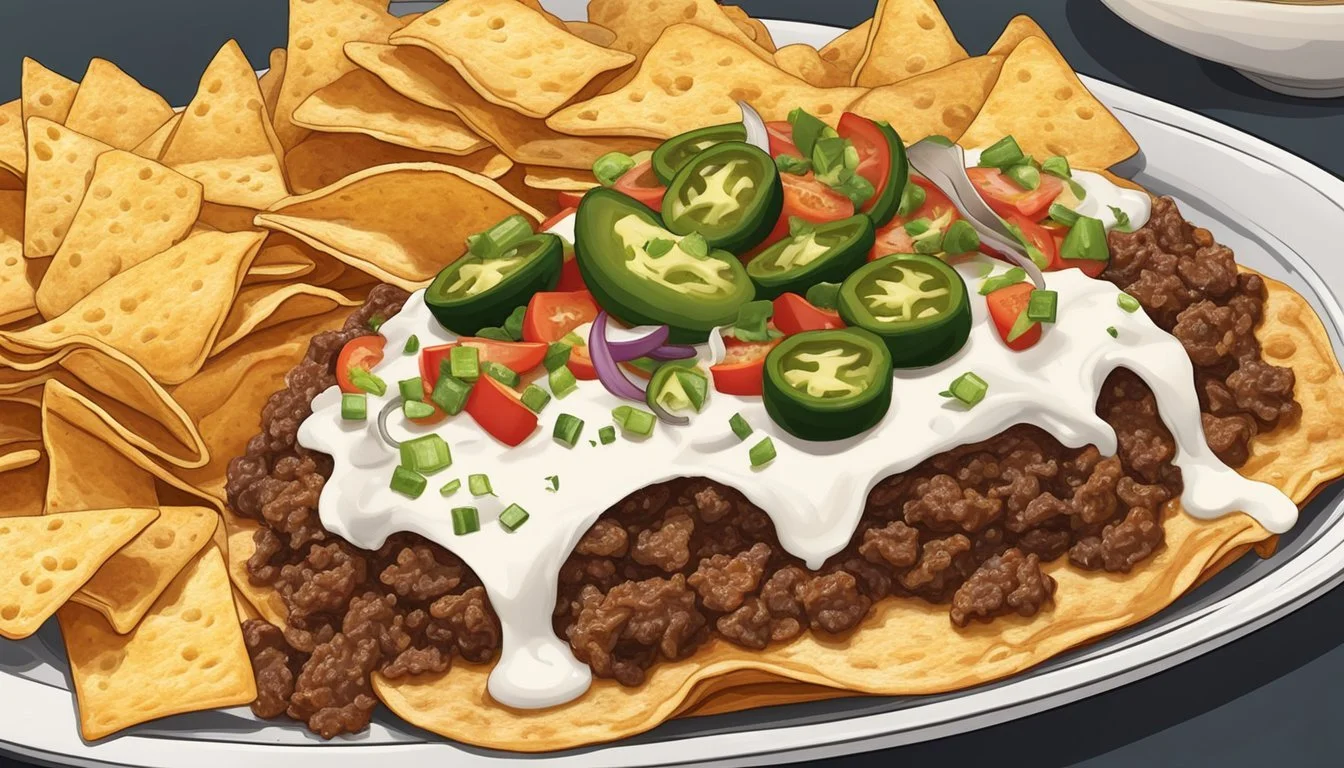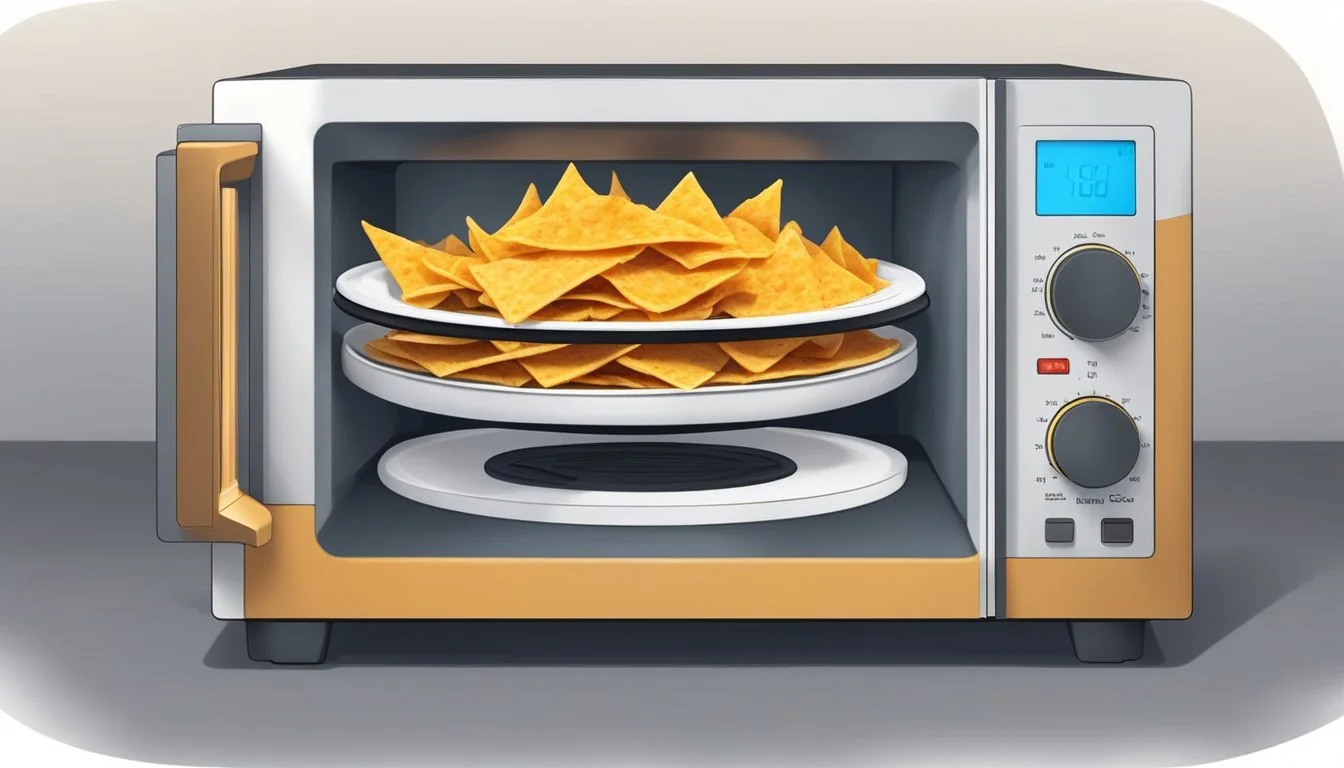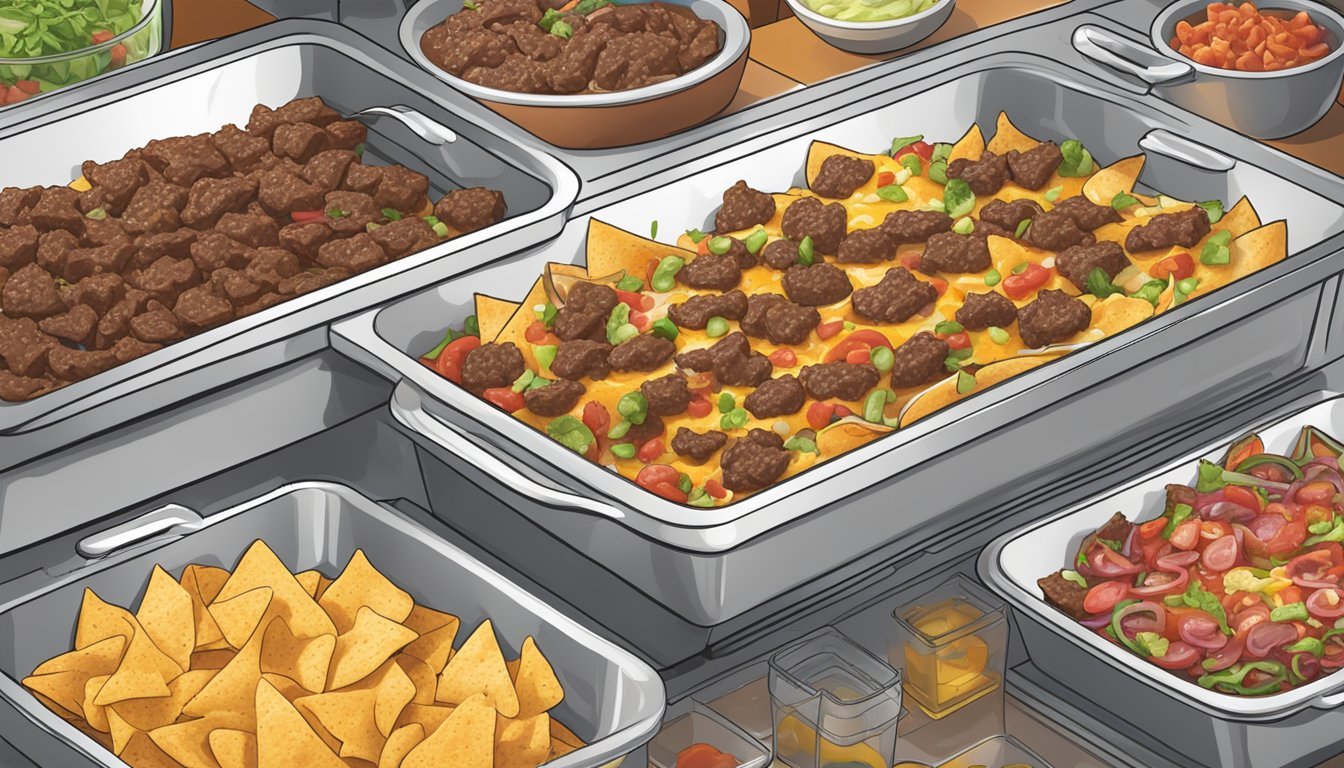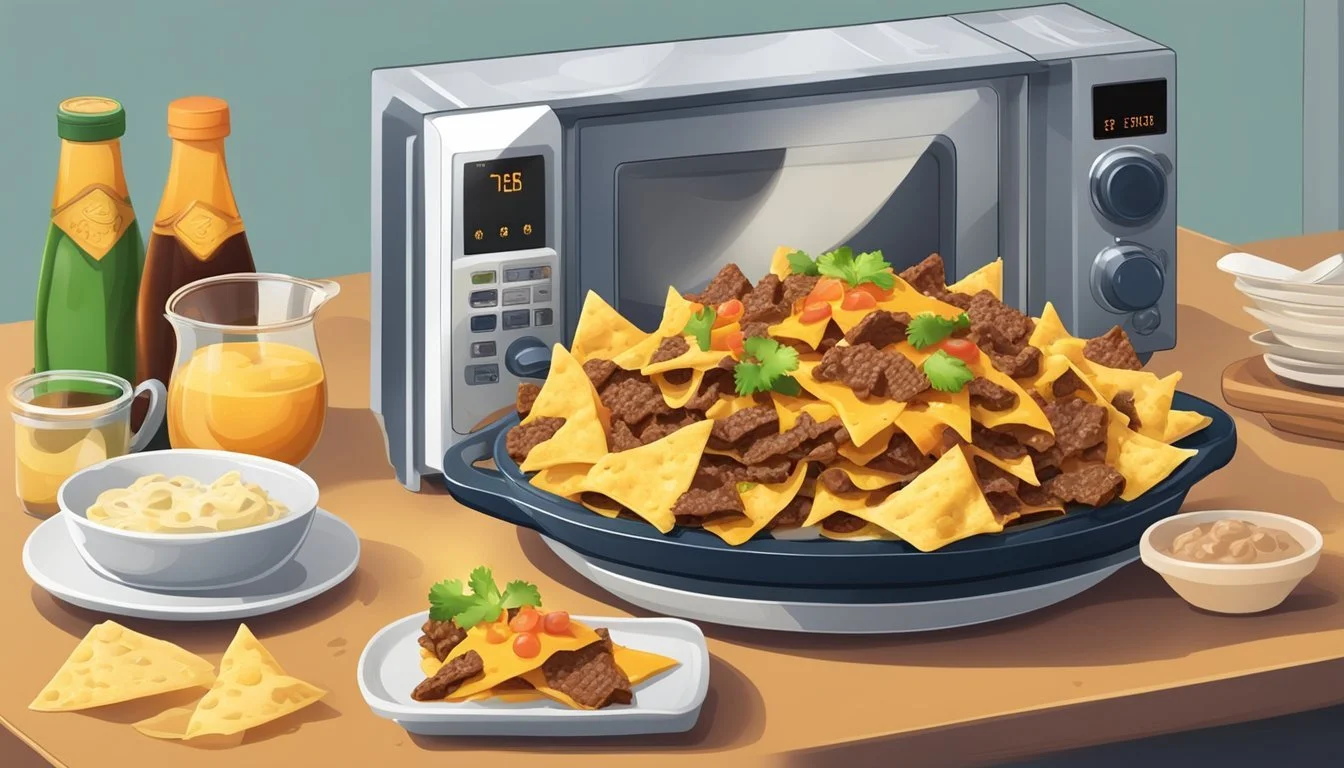How to Reheat Beef Nachos
Easy Methods for Perfect Crunch
Reheating beef nachos can be tricky, but it is entirely possible to bring them back to their former glory. To reheat beef nachos and keep them crispy, use an oven preheated to 275°F (135°C) for 5 to 10 minutes. This method ensures the cheese melts and the chips retain their crunch. For a quick alternative, an air fryer set to 300°F (150°C) also works well; just heat the nachos for 3-4 minutes.
Leftover nachos don't have to be a disappointment. Reheating them properly can make them taste just as delicious as when they were first made. Removing cold toppings before reheating and spreading out the nachos evenly in the oven or air fryer guarantees that each chip remains crispy. Nacho lovers will appreciate the difference.
For those who cherish the perfect nacho experience, maintaining crispiness and flavor is key. Keep portions manageable by not overcrowding your cooking pan or basket. This small step makes all the difference and results in crispy nachos that will satisfy any craving for this beloved dish.
Understanding Nachos and Reheating Basics
Nachos consist of crispy tortilla chips, melted cheese, and various toppings such as beef, jalapeños, and beans.
Quality is key when it comes to reheating beef nachos.
To maintain the crispy texture of the tortilla chips, methods involving dry heat are most effective.
Common Reheating Methods
Oven: Preheat to 300°F (150°C), remove cold toppings, and bake for about 10-15 minutes or until the cheese melts.
Microwave: Use for quick reheating but might make chips soggy. It's best to add a paper towel underneath.
Skillet: Heat a skillet over medium heat, place the nachos in, cover with a lid, and heat for a few minutes.
Tips to Keep Nachos Crispy
Separate cold toppings like sour cream and guacamole before reheating.
Use aluminum foil to cover the nachos if using the oven to evenly distribute heat without overcooking.
Special Considerations for the Cheese
Melted cheese is a critical component. The reheating method should ensure that the cheese melts evenly without burning.
Proper reheating guarantees the beef remains juicy and toppings are suitably warm.
Maintaining the balance between warm toppings and crispy chips makes for the best nacho experience.
Understanding these basics ensures that reheating nachos brings back their original deliciousness and texture.
Preparing Nachos for Reheating
When dealing with leftover beef nachos, the preparation process ensures they come out crispy and delicious.
Remove Cold Toppings: Start by removing any cold toppings. Lettuce, guacamole, sour cream, and tomatoes should be set aside as they can make the nachos soggy when reheated.
Separating Ingredients: Separate components like cheese, beans, and meat from the chips if possible. This step allows for a more even reheating process and prevents the toppings from overcooking.
Storage: If you know in advance that you will have leftovers, store the nachos properly. Use an airtight container to keep them fresh in the refrigerator. It prevents the nachos from absorbing moisture and becoming soggy.
Spread Evenly: Before reheating, spread the nachos out evenly on a baking sheet or in an air fryer basket. Spreading them out ensures that each chip gets reheated properly, maintaining a crispy texture.
Check for Freshness: Always check that the meat and beans are still good to eat before reheating. If any component looks or smells off, it's better to discard it.
By preparing the nachos correctly, you can enjoy reheated nachos that are almost as good as when they were first made. Proper preparation is key to keeping your nachos tasty and crispy.
Oven Reheating Method
Reheating beef nachos in the oven ensures even heating and helps maintain a crispy texture. This method involves preheating the oven, using a baking sheet and aluminum foil, setting the optimal temperature and time, and monitoring moisture and crispiness.
Preheating the Oven
To start, preheat the oven to 275°F (135°C). Preheating is essential to ensure that the nachos heat evenly without becoming soggy. A slower, steady heat lets the toppings warm up without burning the chips. It is important not to rush this step, as a properly preheated oven contributes significantly to the final texture of the nachos.
Using a Baking Sheet and Aluminum Foil
Arrange the nachos in a single layer on a baking sheet covered with aluminum foil. The aluminum foil serves two purposes: it facilitates even heating and prevents sticking. Make sure to spread the nachos out to avoid clustering, which can lead to uneven reheating. If desired, you can use parchment paper as an alternative to foil.
Optimal Oven Temperature and Time
For the best results, reheat the nachos at 275°F (135°C) for 5-10 minutes. This temperature is warm enough to heat the beef and melt any cheese without burning the nachos. The time may vary depending on your oven's efficiency and the amount of nachos. It is advisable to check the nachos after 5 minutes and keep a close eye on them to avoid overcooking.
Monitoring Moisture and Crispiness
To achieve a crispy texture while preventing sogginess, avoid reheating any cold toppings like lettuce and guacamole. These should be removed before placing the nachos in the oven and can be added back afterward. Check the nachos periodically to assess their moisture and crispiness. If they seem too dry, consider covering them loosely with another sheet of aluminum foil midway through reheating to retain moisture. Alternatively, switch the oven setting to broil for the last minute or two to enhance crispiness without overcooking the rest of the nachos.
Microwave Reheating Method
To effectively reheat beef nachos in a microwave, ensure even heating, maintain moisture, and avoid sogginess. Use a microwave-safe dish, paper towels, and adjust the microwave time and power.
Setting Up Microwave-Safe Dish
Start by placing your beef nachos on a microwave-safe plate. A glass or ceramic dish is ideal. Spread the nachos in an even layer to prevent cold spots.
Arrange the nachos so that each chip has some beef and cheese. Make sure the nachos are evenly distributed, and avoid stacking to achieve uniform reheating. Using a microwave-safe lid or plastic wrap can help retain moisture.
Avoiding Sogginess with Paper Towels
Prevent soggy nachos by employing paper towels. Before reheating, place a paper towel over the nachos.
The paper towel absorbs excess moisture, ensuring the nachos stay crispy. To avoid touching the toppings directly, use a layer above the cheese and beef. This step is crucial for maintaining the desired texture of the nachos.
Determining Microwave Time and Power
Set your microwave to medium-high power to reheat the nachos. Begin by microwaving for 1-2 minutes. Check the nachos periodically to prevent overheating or uneven warming.
Since microwaves vary, you may need to adjust the time. Ensure the cheese is melted and the beef is heated through. If necessary, microwave in 15-30 second increments. Avoid reheating for too long to prevent sogginess and overcooked beef.
Skillet Reheating Method
Reheating beef nachos in a skillet ensures they remain crispy while sufficiently warming the cheese and toppings. Follow these steps to enjoy delicious and crunchy nachos.
Utilizing Medium-High Heat
Start by placing a large skillet on the stovetop and setting the burner to medium-high heat. Apply a light coat of cooking spray or a small amount of oil to the skillet to prevent sticking. Distribute the nachos evenly across the surface, ensuring a single layer for even heating.
Maintain medium-high heat to ensure the nachos heat through without burning. Adjust the heat if necessary to avoid scorching the bottom layer.
Achieving Crispiness without Burn
To achieve crispy nachos without burning, frequently move the nachos around with a spatula. This helps to evenly expose the chips to the heat and enhance their crunch.
Keep an eye on the skillet and avoid covering it, as trapping steam can make the nachos soggy. Aim for a slight browning of the chips, which typically takes around 5-7 minutes.
Managing Cheese Melt and Toppings Reintegration
Remove any cold toppings like lettuce or sour cream before reheating. Heat the nachos until the cheese starts to melt, then turn off the stove and begin reintegrating the toppings.
Layer the toppings back onto the nachos while still in the skillet or on a separate plate immediately after taking them off the heat. Ensuring the cheese melts without hardening is key; the residual heat in the skillet will help achieve this balance.
These steps provide a clear and effective guide on how to reheat nachos in a skillet, ensuring they retain their crispiness and flavor.
Other Reheating Appliances
For those without traditional ovens, air fryers and toaster ovens offer efficient alternatives for reheating beef nachos. Both appliances help maintain the crispiness of the nachos while avoiding sogginess.
Using an Air Fryer for Reheating
To reheat nachos in an air fryer, first preheat the appliance to 300°F (150°C). Remove all cold toppings to prevent them from becoming soggy. Arrange the nachos in a single layer inside the air fryer basket to ensure even heating. Heat the nachos for about 3-4 minutes, checking frequently to avoid overcooking.
An air fryer’s quick and even heating makes it ideal for achieving crispy, rejuvenated nachos. Keep an eye on the food as air fryer intensities may vary, requiring slight adjustments in cooking time.
Toaster Oven Reheating Technique
Set the toaster oven temperature to 225°F (107°C) to reheat your beef nachos. Similar to the air fryer method, remove any cold toppings before starting the process. Spread the nachos on a wire rack or baking sheet, ensuring they are evenly spaced out.
Bake for 10-15 minutes, monitoring them to prevent burning. A wire rack allows air circulation around the nachos, maintaining their crispness. The toaster oven method is convenient and efficient for smaller batches, and its moderate heating helps avoid overly dry nachos.
Using these appliances, you can enjoy your nachos with satisfying texture and taste.
Handling Cold Toppings and Add-Ons
Cold toppings can significantly affect the quality of reheated nachos. Before reheating, remove items like sour cream, guacamole, lettuce, salsa, and pico de gallo. Set them aside to prevent sogginess and maintain freshness.
When it comes to jalapeño peppers and olives, consider your personal preference. If you enjoy them warm, they can remain on the nachos. Otherwise, remove them and add them back after reheating.
For best results, follow these steps:
Remove Cold Toppings: Gently scrape off sour cream, guacamole, lettuce, salsa, and other fresh toppings.
Reheat Nachos Using Your Preferred Method: Options include oven, air fryer, or microwave. Ensure the chips and hot ingredients are evenly heated.
Add Cold Toppings Back: Once reheated, replace the cold toppings. This keeps the toppings fresh and crisp.
Here’s an example layout:
Cold Topping Remove Before Reheating Add After Reheating Sour Cream Yes Yes Guacamole Yes Yes Lettuce Yes Yes Salsa Yes Yes Pico de Gallo Yes Yes Jalapeño Peppers Optional Optional Olives Optional Optional
This approach ensures that your beef nachos remain both delicious and visually appealing after reheating.
Serving and Presentation
When serving reheated beef nachos, presentation is key to making the dish appealing. Serve the nachos on a baking tray lined with parchment paper to keep them crisp and attractive. This method also makes for easy cleanup.
For an added touch, arrange the nachos neatly on the tray, avoiding overlap where possible. Consider adding a variety of toppings such as refried beans, fresh salsa, cheese sauce, and guacamole.
Use small bowls for dips like sour cream and cheese sauce. This adds an element of snack-style presentation, making it easy for guests to enjoy.
A sprinkle of fresh herbs or a squeeze of lime juice can enhance the visual appeal and flavor. Use a table to keep things organized and attractive:
Component Presentation Tip Beef Nachos Serve in single layer on parchment paper Refried Beans Serve in a separate bowl Cheese Sauce Drizzle in a zigzag pattern Tortilla Chips Arrange neatly on the tray Fresh Salsa Provide in a small bowl
Pair the nachos with a cold drink for a complete snack experience. Using small serving trays can make it easier for guests to enjoy each component, ensuring a satisfying presentation.
Additional Tips for Nacho Reheating Success
To keep your beef nachos crispy, preheat your oven to 300°F and spread the nachos evenly on a baking sheet. Cover the nachos loosely with aluminum foil to prevent them from getting too dry.
Moisture control is key. If the nachos have wet toppings like salsa, refried beans, or sour cream, remove these toppings before reheating. Add them back after reheating.
*For crispier nachos, use an air fryer at 350°F for 5 minutes. This method helps maintain their texture and ensures even reheating without making the nachos soggy.
Ground beef and other toppings should be spread evenly. Reheat separately if necessary, especially if the toppings are very moist. Microwave the toppings for a quick and easy option.
Reheating leftover nachos for a different dish like chilaquiles? Break up the nachos and heat them in a skillet. Add some scrambled eggs and a bit of sauce for a delicious new meal.
Keep store-bought nachos in a cool, dry place to maintain their quality. To revive stale nachos, bake them at 350°F for a few minutes to regain their crunch.
Layering method: Place a layer of nachos, then a layer of toppings, and repeat. This ensures even reheating and helps maintain the crispy texture.
Quality cheese matters. Freshly grated cheese melts better and provides a more enjoyable reheating experience. Avoid using pre-shredded cheese which contains anti-caking agents.
Use parchment paper. Lining your baking sheet with parchment paper can prevent sticking and make cleanup easier.







